Transylvania Travel Guide
Thanks to the legend of Dracula, Transylvania remains one of the most famous regions of Romania, conjuring up images of haunted forests, vampires, werewolves, medieval towns, dramatic mountains and turreted cliff-top castles.
The charming town of Sighisoara is the most striking introduction to the birthplace of 'Dracula', a medieval prince named Vlad Tepes who led the Romanian resistance against the Turks. The wider region is famous for the castles and churches of Brasov and Sinaia, and the dramatic castle of Bran. Also known as Dracula's Castle, Bran looks every bit a vampire's lair with its soaring turrets and dramatic setting.
Transylvania is not just about Dracula, however. It contains splendid mountain scenery and alpine peaks, some of the country's best hiking and skiing, rural villages, and a way of life that remains almost as it was in the 18th century. Historic towns with stone medieval streets, defensive towers and fortified churches are scattered throughout the region.
The populace is a melting pot of different cultures and customs that have been shaped by years of colonisation and the coming and going of different groups, including Romanians, Gypsies, Hungarians and Germans. Despite the creeping effects of modernisation into the larger towns, visitors to this region can still enjoy its medieval charm and the traditional character of the people. Images of horse-drawn carts piled high with cabbages, driven by elderly couples with scarf-covered heads and rough hands; lively food markets, quaint cobbled streets, and hilly pastures nestled among the Carpathian Mountains will be the lasting impressions left by the charm of Transylvania.
Things to do in Transylvania
In the heart of Romania, surrounded by Carpathian mountain range is the historical and mythical region of Transylvania. An intriguing part of the country with unparalleled attractions, Transylvania draws in visitors of all kinds for a unique European holiday.
The charms of Transylvania entice people with the imagery of haunted forests, medieval towns, vampires, turreted cliff-top castles, and the legends of Dracula. But in addition to its medieval castles and enchanting historic towns, the region also offers dramatic alpine scenery of the Carpathian Mountains with spectacular skiing and undisturbed hiking opportunities.
A definite must-see when in the region is the Peles Castle, considered to be one of the finest castles in Europe. The views from the castle are incredible and for lovers of Neo-Renaissance architecture and sculpture, the castle certainly delivers.
A trip to Transylvania would not be complete without exploring Bran Castle, the inspiration behind Bram Stoker's novel, Dracula. Here visitors will be exposed to striking architecture and historical artefacts, as well as experience what it means to be in the land of Dracula! While visiting Bran Castle, it's certainly worth visiting the archetypal medieval town of Brasov. This wonderfully European town is known for its architecture and stunning views of the Carpathian Mountain range.
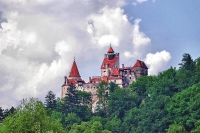
Bran Castle
Often referred to as 'Dracula's Castle', the fortified medieval Bran Castle is a national monument and landmark of Romania. Looking exactly as a vampire count's lair should, the forbidding façade, towers and ramparts rise out of the forest, perched high on a steep cliff face against a dramatic mountain background. Despite its aesthetic, there is little evidence to suggest Vlad Tepes, the speculated inspiration for Dracula, ever lived there. Bran Castle was built between 1377 and 1388 to protect nearby Brasov from invaders. The rooms and towers surround an inner courtyard with a sculpted stone fountain. A warren of narrow, winding stairs, secret chambers and underground passageways lead between vaulted halls, a prison, a living area and watchtowers with sweeping views. The rooms are decorated with a collection of Baroque furniture, elaborately carved four-poster beds, weapons and armour dating from the 14th to 19th centuries. A fascinating site, visitors should have this near the top of their Romanian to-do list.
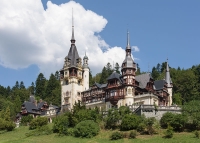
Peles Castle
The quintessential fairytale castle, complete with turrets and surrounded by mystical forests, the neo-classical Peles Castle was the summer residence of Romania's kings, and makes for a highly popular tourist attraction. Built by King Carol I in 1883, the castle is a masterpiece of German new-Renaissance architecture, its exquisite form framed by fir forests and the towering peaks of the Carpathian range. The castle's 160 rooms are lavishly decorated in ebony, mother of pearl, walnut, and leather, with crystal chandeliers, fine collections of sculptures, paintings and tapestries, and stained-glass windows and furniture. It is set within a large park with a statue garden in front. Further up the hill from the main palace is the smaller Pelisor Palace, built for Carol I's nephew and heir, and decorated in the Art Nouveau style.
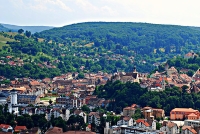
Sighisoara
Sighisoara is a beautifully preserved medieval town, renowned as the birthplace of 'Dracula', or Vlad the Impaler. It is also a UNESCO World Heritage Site and one of the seven fortified towns founded by the Saxons in the hills of Transylvania. The hilltop citadel dominates the town, with the original medieval settlement enclosed within the fortress walls, surrounded by nine surviving towers. Visitors will love exploring the old town, with its narrow cobbled streets and steep alleyways, brightly-painted lopsided houses, ancient churches, stone archways and covered stairways, all of which are watched over by the striking Clock Tower. At the foot of the Clock Tower is the simple yellow building where Vlad was born and lived with his father, Vlad Dracul. Marked by a hanging wrought-iron dragon, it now houses a restaurant with medieval furnishings.
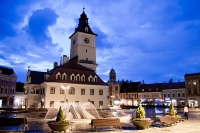
Brasov
Nestled at the foot of Mount Tâmpa is the charming medieval town of Brasov which, being one of the seven fortified towns settled by the Saxons, has a distinct Germanic flavour to its history and culture. The Saxons built massive stone walls and seven bastions around the city that are still visible today, as well as ornate churches, elaborately trimmed buildings, and a fine central square that is said to be where the legendary Pied Piper led the children of Hamlin. Lining the square are the red-roofed merchant's houses, now occupied by cafes and shops surrounding the 15th-century Old Town Hall. The town's landmark is the impressive Gothic structure known as the Black Church, so named because a fire blackened its outer walls in 1689. Many tourists use Brasov as a base for visiting the nearby attractions such as Dracula's Castle at Bran, Râsnov Castle and the ski resorts of Sinaia and Poiana Brasov.
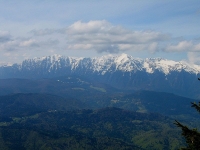
Sinaia
Known as the 'Pearl of the Carpathians' for its beautiful mountain scenery, Sinaia is nestled in the Prahova valley, surrounded by the snow-covered peaks of the Bucegi Mountains. It is also the setting for Peles Castle, a beautiful creation in the German new-Renaissance style, and considered to be one of the finest castles in Europe. With the construction of the castle as a summer residence for King Carol I, the little hamlet became an exclusive aristocratic resort and today is filled with holidaymakers who come to walk or ski in the mountains. The Sinaia Monastery behind the Orthodox Church has a small museum displaying some of the town's treasures, including a beautiful 1668 bible translated into Romanian using the Cyrillic alphabet. The resort also boasts a 17th-century monastery with original frescoes, and the small Pelisor Palace.
Romania travel info
Electricity
The electrical current is 230 volts, 50Hz. Two-pin European-style plugs are standard.
Language
Romanian is the official language, but English will be understood in Bucharest and other tourist areas.
Money
The Leu (RON) is the official currency, which is divided into 100 bani. Money can be exchanged at banks, international airports, hotels, or authorised exchange offices (casa de schimb or birou de schimb valutar). ATMs are everywhere and give 24-hour withdrawals; international credit cards are widely accepted in hotels, restaurants and shops in cities and large towns.
Tipping
Tipping is becoming increasingly common in Romania, and is now expected in all restaurants and bars. A service charge is often included in restaurant bills but a further 5 to 10 percent tip is expected. Though it is not always necessary to tip them, taxi drivers can be rewarded for good service.
Health
Medical facilities in Bucharest are good, but poor in the smaller towns and basic medical supplies are often in short supply. There is a reciprocal health agreement with most EU countries, whose citizens are entitled to free or low-cost emergency medical treatment on presentation of a European Health Insurance Card (EHIC), but travel health insurance is strongly advised. After Brexit, the Global Health Insurance Card (GHIC) replaced the European Health Insurance Card (EHIC) for UK citizens. The GHIC allows UK citizens access to state healthcare during visits to the EU. The GHIC is not valid in Norway, Iceland, Liechtenstein or Switzerland, nor is it an alternative to travel insurance. There have been a number of Hepatitis A cases in Romania and visitors are advised to seek medical advice about inoculations before travelling. Tap water is safe to drink, although bottled water is widely available. Stray dogs might carry rabies in remote regions and should be avoided.
Safety
Visitors should take normal safety precautions in Romania, such as keeping valuables safe and being aware of pickpockets and scam artists in major cities. Corruption is less rife these days, but visitors should be cautious of policemen demanding fines for spurious offences, or asking to see documents as a way of stealing cash. If approached in this way, visitors should offer to go with them to the nearest police station before handing over any money or documents. Travellers should not leave valuables, including passports, in hotel rooms, or near the window of a hotel room when they are not there.
Local customs
It is illegal to change money on the streets. Homosexuality, although legal, is frowned upon. A small and still largely closeted gay scene exists in the Romania's largest cities, particularly in Bucharest, which has a few gay clubs. Photography at airports is prohibited.
Doing business
Business can be quite bureaucratic and old-fashioned. The country adheres to an imbedded hierarchical structure and often it is the eldest who receive the most respect in business and social meetings. It is important to address each person according to their title followed by their surname; 'Domnule' for Mr. and 'Doamna' for Mrs. Romanians prefer a face-to-face approach and like to strengthen personal relationships. Appointments should be made in advance and confirmed. Although the visitor is expected to be punctual the host may be late to arrive. Meetings are often quite formal and a general 'Western' set of old-world manners applies. Business suits are appropriate for meetings. Romanians dislike an overt display of achievement or exaggerated conversation. Business hours are generally 9pm to 5pm Monday to Friday with an hour taken at lunch.
Duty free
Travellers visiting Romania from outside the EU do not have to pay duty on 200 cigarettes, 50 cigars or 250g of tobacco. Two litres of spirits, 16 litres of beer, 4 litres wine, and gifts to the value of US$430 are also duty free. Those arriving from inside the EU do not have to pay duty on 800 cigarettes, 200 cigars or 1 kg of tobacco, 10 litres of spirits, 110 litres of beer, and 90 litres of wine.
Communications
The direct dialling country code for Romania is +40, and the outgoing code is 00, followed by the relevant country code (e.g. 0044 for the UK). Free wifi is available at cafes, hotels and restaurants. A local SIM card can be purchased as a cheaper alternative to using international roaming for calls.
Passport & Visa
Visitors must hold all documents required for further travel, onward or return tickets. It is highly recommended that travellers' passports have at least six months validity' remaining after their intended date of departure from their travel destination. Immigration officials often apply different rules to those stated by travel agents and official sources.
Entry requirements
United States nationals require a passport valid for three months beyond period of intended stay. No visa is required for stays of up to 90 days within a 180-day period.
UK nationals require a passport valid for three months beyond period of intended stay. No visa is required for stays of up to 90 days within a 180-day period.
Canadian nationals require a passport valid for three months beyond period of intended stay, but no visa for stays of up to 90 days within a 180-day period.
Australian nationals require a passport valid for three months beyond period of intended stay, but no visa for stays of up to 90 days within a 180-day period.
South Africans require a passport valid for three months beyond period of intended stay and a visa to enter Romania. Holders of a valid Schengen visa, or holders of a short stay visa issued by Bulgaria, Croatia, or Cyprus do not require a visa to enter Romania for a stay of up 90 days within a 180-day period. South African temporary passports are not accepted by the Romanian government.
Irish nationals require a passport valid for period of intended stay, but no visa is required.
New Zealand nationals require a passport valid for three months beyond period of intended stay, but no visa for stays of up to 90 days within a 180-day period.
Useful contacts
Romanian Tourist Office, Bucharest: www.romaniatourism.com
Emergencies: 112.


